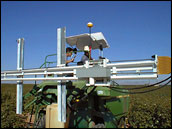| |
According to Moran, the term
"precision farming" refers to the use of an information and
technology-based system for within-field management of crops. "It
basically means adding the right amount of treatment at the right time
and the right location within a field—that’s the precision
part," Moran explains. "Farmers want to know the right
amounts of water, chemicals, pesticides, and herbicides they should use
as well as precisely where and when to apply them."
Critical to the success of precision farming is the sophisticated new
equipment that is now commercially available. Called "variable
rate technologies," there are devices that can be mounted on
tractors and programmed to control the dispersion of water and chemicals
based upon the information gained from the remote sensors.
Thanks to the marriage of remote sensing data with GIS and GPS software tools, and on-tractor variable rate technologies, farmers no longer must treat a field of crops as one homogeneous unit. Charles Walthall, also a research physical scientist at the U.S. Department of Agriculture in Beltsville, recalls that the old way of doing business was planting a crop and then applying fertilizer evenly across the whole field.
"But
now we’re characterizing zones within the field so we
can optimize what inputs are needed to go into that zone according to
what they need to produce the crop," Walthall says. "But if you
limit your inputs—such as fertilizers, seeds, water, pesticides, or
herbicides—to precisely where and how much is needed, you are
putting less on the landscape. So the cost is less and energy is saved,
which means better profit."
|
|

Critical to precision farming is the sophisticated new
equipment that is now commercially available. The photo above shows a
tractor with an imaging system attached on a track to obtain spectral
measurements within a field. These measurements provide information
about the health of a crop. [Photograph courtesy United States Department of Agriculture (USDA)
Agricultural Research Service]
|
| |

Perhaps more significantly, it can mean there is much less chemical
runoff from farms to negatively impact the environment. According to Walthall,
state-sponsored agencies are passing laws limiting the types and amounts
of chemicals that farmers can use. The State of Maryland, for instance,
passed a law requiring farmers to have a documented "phosphorus
management plan." (This law is particularly enforced in the
Chesapeake Bay region where the runoff of phosphates into the bay can
contribute to harmful algae blooms and other negative environmental
impacts.) Other states are considering similar laws aimed at regulating
the use of nitrogen. Too much nitrogen in the water supply is a health
hazard to both humans and animals.
But by using the tools of precision farming, growers can specifically
target areas of need within their fields and apply just the right
amounts of chemicals where and when they are needed, saving both time
and money and minimizing their impact on the environment.
 Our Most Precious Resource Our Most Precious Resource
 The Right Stuff The Right Stuff
|
|
Ultra-low volume herbicide application
methods (developed by Agricultural Research Service plant physiologist Chester McWhorter
and colleagues) combined with new techniques to determine where pesticides are needed could significantly reduce the use of agricultural chemicals. (Photograph by Keith Weller, courtesy USDA Agricultural Research Service) |

